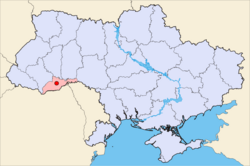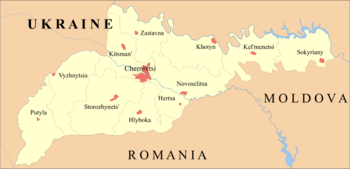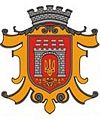Chernivtsi
| Chernivtsi Чернівці |
|||
|
|
|||
|
|||
| Nickname(s): Little Vienna | |||
 |
|||
| Coordinates: | |||
| Country | |||
|---|---|---|---|
| Oblast | Chernivtsi Oblast | ||
| City Municipality | Chernivtsi City Municipality | ||
| First mentioned | 1408 | ||
| City rights | 14th century | ||
| Raions |
3
|
||
| Government | |||
| - Mayor | Mykola Fedoruk | ||
| Area | |||
| - Total | 153 km² (59.1 sq mi) | ||
| Population (2001 census) | |||
| - Total | 242,300 | ||
| - Density | 1,625/km² (4,208.7/sq mi) | ||
| Time zone | EET (UTC+2) | ||
| - Summer (DST) | EEST (UTC+3) | ||
| Postal code | 58000 | ||
| Area code(s) | +380 372 | ||
| Sister cities | Salt Lake City, Konin, Suceava, Nazareth Illit, Saskatoon, Klagenfurt, Podolsk | ||
| Website: http://www.city.cv.ua/ | |||
Chernivtsi (Ukrainian: Чернівці; See #Name section) is the administrative center of Chernivtsi Oblast (province) in western Ukraine. The city lies in the historic Northern Bukovyna region of Ukraine and is situated on the Prut River, a tributary of the Danube. As of the 2001 Ukrainian Census, the city's population is 242,300.
Together with the city of Lviv, Chernivtsi is considered to be a cultural centre of western Ukraine. Many famous Ukrainians were born or lived in the city, including the poet Ivan Franko, the first President of Ukraine Leonid Kravchuk, and former Speaker of the Parliament Arseniy Yatsenyuk. Additionally, many other well known historical figures were born in the city, such as the Vienna Secession artist Oskar Laske. Chernivtsi is also considered as one of Ukraine's greatest cultural and educational centres in history. As a cultural and architectural center, Chernivtsi was dubbed as Little Vienna,[1][2] Jerusalem upon the Prut and the European Alexandria.
Chernivtsi is currently twinned with eight other cities around the world. Chernivtsi is also a major point of railway and highway crossings in the region, and houses an international airport.
Contents |
Geography
Chernivtsi is located in the historic Northern Bukovyna region of western Ukraine. The city lies 248 meters above sea level and is surrounded by forests and fields. The Prut River runs through the city's landscape.
History
Chernivtsi continues to hold a prominent position among other Ukrainian and Eastern European cities. The city's ancient beginnings and significant history add to its charm and attraction for those interested in the Bukovynian Region.
Archeological evidence discovered in the area surrounding Chernivtsi indicates that a local population existed in that area since the neolithic era. Later settlements included those of the Trypillian culture (Cucuteni),[3] the Corded Ware culture; artifacts from the Bronze and Iron ages were also found in the city. Remains of the early Slavic tribes in the area date back to the 2nd–5th centuries, with the artifacts of Chroatian and Tiverian peoples from the 9th–11th centuries also being present.

A fortified settlement located on the left shore of Prut dates back to the time of the Principality of Halych and is thought to have been built by Grand Prince Yaroslav Osmomysl, who ruled from 1153-1187.[4] Legendary accounts refer to this fortress-city as Chern’, or Black city, and it is said to owe its name to the black color of the city walls, built from dark oak layered with local black-colored soil.[5] This stronghold was unfortunately destroyed during the Mongol invasion of Rus by the Burundai in 1259. However, the remaining ramparts of the fortress were still used for the defense purposes; they were augmented with several bastions, one of which is still extant, in the 17th century. Following the destruction of the fortress, later settlements in the area centered to the right of the Prut River, at a more strategically advantageous, elevated location.
Beginning in 1359, for more than 400 years, the city and its surroundings became part of the Principality of Moldavia.
The city became a part of the Duchy of Bukovina, a crownland of the Austrian Empire, in 1775 and received the Magdeburg rights soon thereafter.[6]
The city began to flourish in 1778 when Knight Karl von Enzenberg was appointed the chief of the Military Administration of Chernivtsi. He invited many merchants, craftsmen and business people to help develop trade and other businesses. St.Peter's Fairs (July 1-15) had given a new vibrant impulse to the market development from 1786.
During the 19th and early 20th century, Chernivtsi became a center of the Romanian, and also Ukrainian nationalist movement. Chernivtsi was also the site of the first Yiddish language conference in 1908; this was coordinated by Nathan Birnbaum.
When Austria-Hungary dissolved in 1918, the city and its surrounding area became a part of the Kingdom of Romania.[7] In 1940, Red Army occupied the area and it subsequently became a part of the Ukrainian SSR of the Soviet Union.[7]
Romania liberated the city and occupied much of southern Ukraine in 1941 as part of the Axis attack on the Soviet Union during World War II. When Axis forces were driven out by the Red Army, the city was occupied once again, and rejoined the Ukrainian SSR in 1944.
Since 1991, Chernitvtsi has been a part of independent Ukraine. In May 1999, Romania opened a consulate general in the city. Contemporary Chernivtsi is an important regional center, which is situated on the picturesque banks of Prut River and occupies an area of about 150 square kilometres (58 sq mi).
Government and administrative divisions

Chernivtsi is the administrative center of the Chernivtsi Oblast (province) as well as of the Chernivtsi City Municipality housed within the city. However, Chernivtsi is a city of oblast subordinance, thus being subject directly to the oblast authorities rather to the city municipality housed in the city itself.
The territory of Chernivtsi is divided into 3 administrative raions (districts):
- Pershotravnevyi Raion (Ukrainian: Першотравневий район)
- Sadhirskyi Raion (Ukrainian: Садгірський район)
- Shevchenkivskyi Raion[8] (Ukrainian: Шевченківський район)
The mayor of Chernivtsi is Mykola Fedoruk, who has held the position since 1994.[5]
Demographics
| Historical populations | ||
|---|---|---|
| Census | Pop. | %± |
| 1775 | 2,300 | N/A |
| 1794 | 5,000 | +2.17% |
| 1832 | 11,000 | +2.2% |
| 1869 | 34,000 | +3.1% |
| 1890 | 54,200 | +1.6% |
| 1910 | 87,100 | +1.3% |
| 1930 | 112,400 | +1.1% |
| 1941 | 78,800 | -0.7% |
| 1970 | 187,000 | +2.37% |
| 1984 | 238,000 | +1.27% |
| 2001 | 236,700[9] | +0.99% |
| 2005 | 242,300 | +1.02% |
According to the latest All-Ukrainian population census in 2001, the population of Chernivtsi was approximately 236,700 people of 65 nationalities.[9] Among them, 189,000 (79.8%) are Ukrainians, 26,700 (11.3%) Russians, 10,500 (4.4%) Romanians; 3,800 (1.6%) Moldavians, 1,400 (0.6%) Polish; 1,300 (0.6%) Jews; 2,900 (1.2%) other nationalities.[5]
Based on the latest available Soviet data, the population of the city, as of January 1, 1989, was approximately 295,000 residents. Among these, there are some 172,000 Ukrainians, 46,000 Russians, 16,000 Romanians, 13,000 Moldavians, 7,000 Poles and others.
Historically, the city was very multinational. In 1930, according to the Romanian census, the population of the city was 26.8 % Jewish, 23.2% Romanians, 20.8% Germans, 18.6% Ukrainians, and 1.5% Russians.
The Romanian population in Chernivtsi started decreasing rapidly after 1950. Many Romanians fled to Romania or were deported to Siberia (where most of them died), and the remaining Romanian population quickly became a minority and assimilated with the majority.[10] Nowadays, the Romanian minority in Chernivtsi is still decreasing as a result of cultural assimilation and emigration to Romania.
Chernivtsi once had a Jewish community of 50,000, about half of whom survived World War II thanks to the intercession of a Romanian lawyer and reserve officer, Theodor Criveanu.[11] However, following the collapse of the Soviet Union in 1991, the majority of the Jewish population emigrated to Israel and the United States.
Culture
Architecture
There are many places which attract citizens of Chernivtsi and the visitors: Drama Theatre, Regional Philharmonic Society, Organ and Chamber Music Hall, puppet-theatre, Museum of Local Lore, History and Economy, Museum of Fine Arts, Bukovynian Diaspora Museum, Museum of Folk Architecture and Way of Life, memorial museums of writers, 5 cinemas, 41 libraries, the Central Palace of Culture, 17 clubs, 4 music schools, fine arts school, 2 recreational parks.
The city of Chernivtsi has a lot of architecturally important buildings. Many historic buildings have been preserved, especially within the city's center. However, after years of disrepair and neglect, the buildings are in need of major restoration.
As Chernivsti was part of the Austro-Hungarian Empire, it was closely related to the empire's culture, including architecture. Main architectural styles present within the city include Vienna Secession and Neoclassicism, Baroque, late Gothic architecture, and fragments of traditional Moldavian and Hungarian architecture, Byzantine architecture as well as Cubism.[12] The city is sometimes dubbed Little Vienna, because its architecture is reminiscent of the Austro-Hungarian capital Vienna.[1][2]
The main architectural attractions of the city include: the Chernivtsi Drama Theater (1905); the Chernivtsi University — a former residence of the Metropolitans of Bukovyna (1882); the Regional Museum of Fine Arts — the former savings bank (1900); the Regional Council — former Palace of Justice (1906); and the Chernivtsi Palace of Culture — former Jewish National House (1908); among many others. The magnificent Moorish Revival Czernowitz Synagogue was heavily damaged by fire in 1941, the walls were used to create the "Chernivtsi" movie theater.
The Czech architect Josef Hlavka designed, in 1875, the buildings that currently house the Chernivtsi State University. They were originally the former residence of the Bukovynian metropolitans. The Romanesque and Byzantine architecture is embellished with motifs of Ukrainian folk art; for example, the tile roof patterns duplicate the geometric designs of traditional Ukrainian embroidery.
Sports

The most popular kinds of sports in Chernivtsi include arching, judo, field hockey, karate, power-lifting and orienteering.[13] Chernivtsi's baseball, hockey, and football clubs (FC Bukovyna Chernivtsi) are participants of the Ukrainian national championships.
Chernivtsi has a number of well-developed sports establishments and facilities, including 5 stadiums, 186 sports grounds, 2 tennis courts, 11 football fields, 4 skating rinks, 21 shooting galleries, 3 swimming pools, 69 gyms, and 62 gyms with special training equipment and an international motorcycle racing track.[13]
Over 7,950 inhabitants are members of sport clubs within the city, and more than 50,000 people participate in various sport activities.[13] Currently, 8 sportsmen from the city are the members of national teams and 12 are members in the Ukrainian youth national teams.[13] Three athletes from Chernivtsi were prize-winners of various world tournaments, 2 who were winners of European and 42 of national championships in 2002.[13]
Name
Aside from Ukrainian, Chernivtsi is also known by many different foreign names, which were used during times of rule by different entities throughout the city's history, or by the respective population groups at the time: Russian: Черновцы́, translit. Chernovtsy (until 1944: Чернови́цы, translit. Chernovitsy); German: Czernowitz; Romanian: Cernăuţi; Yiddish: טשערנאוויץ, translit. Tshernovits; Polish: Czerniowce; Hungarian: Csernovic.
See also
- Chernivtsi University
- List of people from Chernivtsi
References
- ↑ 1.0 1.1 "Bukovyna Week in Austria". Den (Zhytariuk, Natalia). Retrieved on 2007-09-26.
- ↑ 2.0 2.1 "Bukovina. The beech tree land". Ukraine Cognita. Retrieved on 2007-09-26.
- ↑ "Trypillya — a culture that was contemporaneous with Ancient Egypt and Mesopotamia". Welcome to Ukraine. Retrieved on 2007-09-27.
- ↑ "City of Chernivtsi -- History". The Komkon Site. Retrieved on 2007-09-25.
- ↑ 5.0 5.1 5.2 "History". Chernivtsi City Official Site. Retrieved on 2007-09-25.
- ↑ "Chernivtsi". Ukrainian heraldy. Retrieved on 2007-09-25.
- ↑ 7.0 7.1 "Bukovina". Encyclopædia Britannica. Retrieved on 2007-09-26.
- ↑ The raion was formerly named Leninskyi Raion. The raion was renamed in accordance with the Rivne Oblast Council's decision.[1]
- ↑ 9.0 9.1 "City of Chernivtsi, Chernivetska Oblast". Verkhovna Rada of Ukraine (December 5 2001). Retrieved on 2007-08-05.
- ↑ For more information, see the Russification article.
- ↑ "Righteous Romanian Honored at Yad Vashem". Bridges for Peace. Retrieved on 2007-09-25.
- ↑ "Sport & Tourism II". Chernivtsi City Official Site. Retrieved on 2007-09-25.
- ↑ 13.0 13.1 13.2 13.3 13.4 "Sport & Tourism". Chernivtsi City Official Site. Retrieved on 2007-09-25.
External links
- "Main Page". Chernivtsi City Official Site/Ukrainian. Retrieved on 2007-09-25.
- "www.czernowitz.de" (in German). Czernowitz Bukowina - Wo Menschen und Bücher lebten. Books and news about Chernivtsi and Bukovina.
- "Chernovtsy" (in Russian). Electronic Jewish Encyclopedia. Retrieved on 2007-09-25.
- "Chernivtsi photo gallery and links". GeoCities. Retrieved on 2007-09-25.
- "Chernivtsi photo gallery".
|
||||||||||||||||||||
|
|||||||||||||||||


